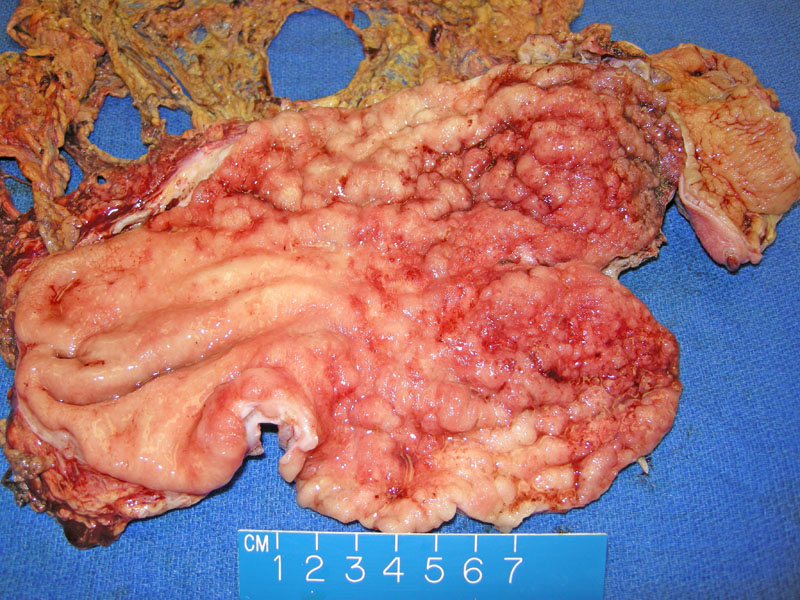

Gastrectomy for linitis plastica shows marked erythyma and wall thickening.
Closer view of the area of malignancy shows a markedly thickened wall.
Endoscopic brushing shows a dirty background with small aggregates of dyscohesive cells which are not those of normal gastric epithelial cells.
The abnormal cells show complete lack of architectural cohesion, and are cytologically composed of uniforma small cells with punctate cytoplasmic mucin and eccentric compressed nuclei, indicative of true signet ring formation.
The biopsy of signet ring cell carcinoma often shows no mass lesion but rather a subtle alteration in the architecture of the glands and stroma.
Higher power is typically required to identify the infiltrate of small individual cells which do not belong in the lamina propria of normal gastric mucosa.
The marked number of malignant cells is best appreciated by keratin AE1/3 immunostaining. Surface normal glands are seen along with the underlying disorganized cords of infiltrating cells.
The resection shows sheets and loose nests of individual small round cells without tubular or glandular formation effacing areas of the muscularis propria.
A lack of adhesion markers allows the cells of this type of gastric carcinoma to grow without cohesion to neighboring cells. The nuclei are eccentric, with a modest amount of cytoplasm. Mitoses are present but overall in fewer numbers than in the intestinal type of gastric carcinoma.
For more detailed information on the background of gastric carcinoma, please visit our case intestinal type gastric carcinoma.
Diffuse type gastric carcinoma, aka signet ring adenocarcinoma, carries an e-Cadherin mutation with a loss of cell to cell adhesion. This type of gastric cancer is seen in a familial gastric cancer syndrome where patients are at increased risk for lobular carcinoma of the breast.1 This makes sense because the diffuse type gastric carcinoma looks very similar to lobular carcinoma of the breast!
The intestinal type occurs at an average age of 55 years with a male predilection (M:F ratio of 2:1). The diffuse type, aka signet ring adenocarcinoma, occurs at a younger age (average of 48) and there is no gender predilection. These tumors are generally asymptomatic until disease is advanced. Presents with nonspecific symptoms such as weight loss, abdominal pain and vomiting, anemia.
Surgical resection +/- adjuvant chemotherapy and radiation.
The depth of invasion, nodal and distal metastasis are important prognostic factors in both intestinal and diffuse types of gastric cancer. Intestinal types tend to have a more favorable prognosis than diffuse types, although new grading schemes for histological types based on glandular differentiation and mucin formation (as better predictors of prognosis) have been proposed.2 Early gastric carcinoma is confined to invasion of the mucosa and submucosa and advanced gastric carcinoma extends beyond the submucosa into the muscular wall.
The 5-year survival rate for early gastric cancer is 90-95%, whereas the 5-year survival rate for advanced gastric cancer is below 15%.1
• Stomach : Adenocarcinoma, Intestinal Type
1 Kumar V, Abbas AK, Fausto N. Robbins and Cotran Pathologic Basis of Disease. 7th Ed. Philadelphia, PA: Elsevier: 2005: 822-6.
2 Rosai, J. Rosai and Ackerman's Surgical Pathology. 9th Ed. Philadelphia, PA: Elsevier: 2004: 672.